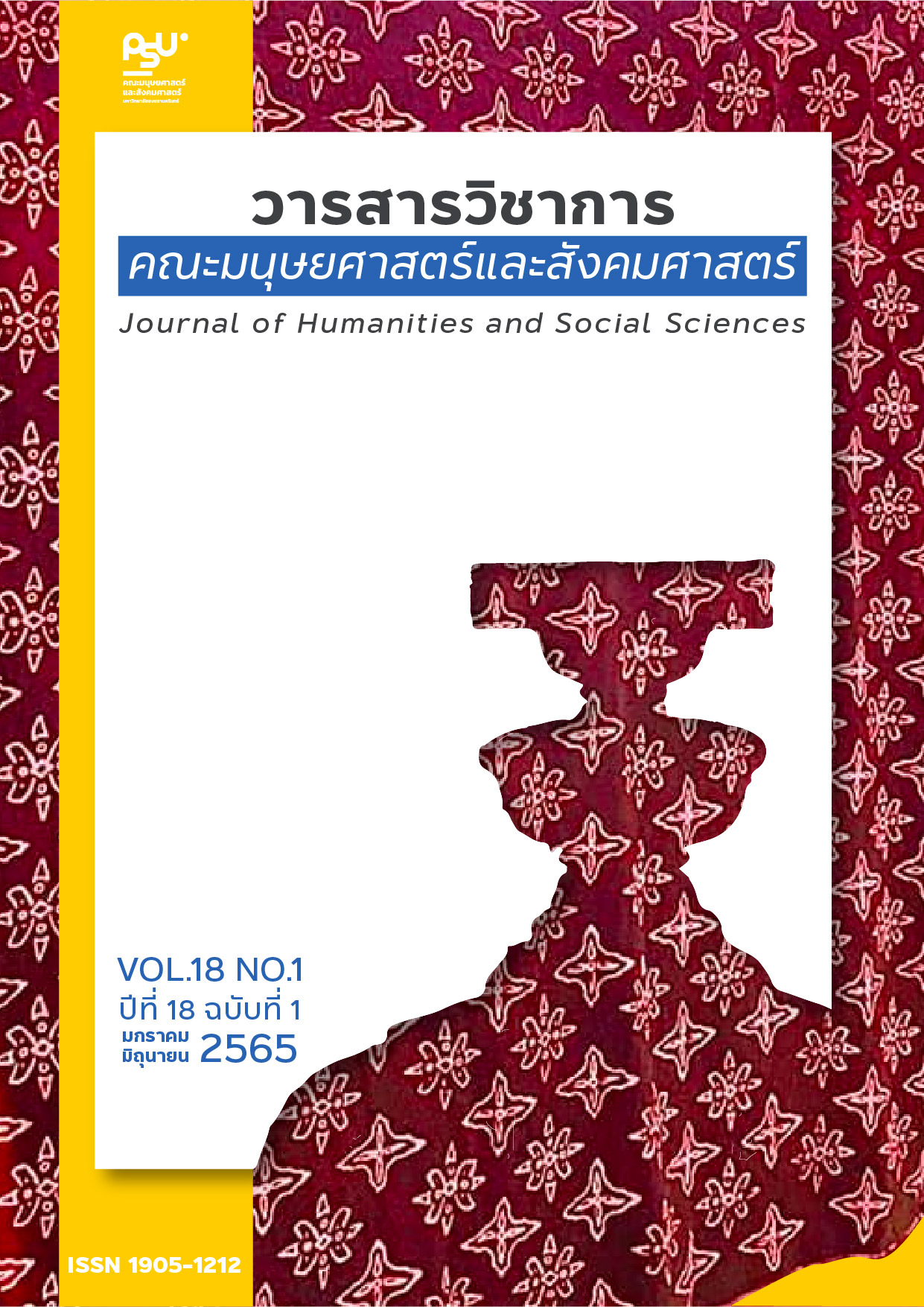Figurative Language in contemporary Korean Teuroteus
Keywords:
Figurative Language, Korean Language, Korean TeuroteusAbstract
The purpose of this research is to study the types of figurative language in Contemporary Korean teuroteus. The data is 280 KoreIncluding metaphor, simile, metonymy, and hyperbole. For the metaphor, it found two types those are metaphor of animation and metaphors of non-animation. As a consequence, they could divide into seven sub-categories according to their meaning, i.e. metaphor of person, metaphor of place, metaphor of vehicle, metaphor of equipment, metaphor of food, metaphor of thing, metaphor of object and metaphor of energy. Whereas the form of metaphorical language reflects the concepts of love is a person, concerning of is a person, date is a people, youth is a people, nature is a people, mind is a place, love is a place, people is a place, man is a boat, loneliness is a food, mind is a thing, date is a thing, youth is a thing, destiny is a book, happiness is liquid, friendship is liquid, and love is energy. The simile in Korean teuroteus compare people, things and feelings with nature, animals, objects such as honey, reeds, butterflies. The word forms used as metonymy were found with two types, THE PART FOR THE WHOLE and THE OBJECT FOR THE USER. Hyperbole refers to an act that is impossible in real life, such as running across an ocean. The occurrence of lightning strikes etc.
The patterns of figurative language used in Contemporary Korean teuroteus arise from both vocabulary and grammar. It observed that there are comparative words in the simile. In addition, comparisons can state by using verbs. From the analysis of Korean teuroteus, it revealed that contemporary Korean teuroteus still use denotative meaning words, emphasizing on the fun of the lyrics and the melodies. The lyrics also tell the daily life stories. Moreover, it also mentions about the season changes, environment, scenery, and the reinforcement for moral support to fight for life.
References
ชัชวดี ศรลัมพ์. (2550). อุปลักษณ์เชิงมโนทัศน์ในนาฏยภาษา (รายงานวิจัย). กรุงเทพฯ :มหาวิทยาลัยธรรมศาสตร์.
นันทนา วงษ์ไทย. (2562). อรรถศาสตร์ปริชานเบื้องต้น. กรุงเทพฯ : บริษัท เวิร์ค ออล พริ๊นท์ จำกัด.
ราชบัณฑิตยสถาน. (2554). พจนานุกรม ฉบับราชบัณฑิตยสถาน พ.ศ. 2554 เฉลิมพระเกียรติพระบาทสมเด็จพระเจ้าอยู่หัวเนื่องในโอกาสพระราชพิธีมหามงคลเฉลิมพระชนมพรรษา 7 รอบ 5 ธันวาคม 2554. กรุงเทพฯ : บริษัท ศิริวัฒนาอินเตอร์พริ้นท์ จำกัด (มหาชน).
สุริยา รัตนกุล. (2544). อรรถศาสตร์เบื้องต้น. นครปฐม : สำนักวิจัยภาษาและวัฒนธรรมเพื่อพัฒนาชนบท มหาวิทยาลัยมหิดล.
วิเศษ ชาษประโคน. (2550). ภาษาไทยเพื่อการสื่อสาร. กรุงเทพฯ : ทริปเพิ้ล กรุ๊ป.
John I. Saeed. (1997). Semantics. Blackwell Publishing.
Sitthinee Thammachai. (2014). Metaphorical expressions in Korean Teuroteus. International Joint Conference on Korean Studies-Thai Studies: Beyond the Horizon and Frontier of Knowledge. Faculty of Humanities Kasetsart University, Bangkhaen Campus. August 28, 2014; 152-163
Ungerer, F.& Schmid H. – J. (1996). An introduction to Cognitive Linguistics. London & New York : Longman.
Mnet. (2019). trot chart - Mnet chart. http://mnet.interest.me/chart/TROT/ALL/, April 19, 2019.
National Institute of Korean Language.(2020). Standard Korean Dictionary (Online). https://stdict.korean.go.kr/main/main.do, April 24, 2020.
Kim Jin Sik. (2007). Modern Korean Semantic Study. Seoul : Park Ijung.
Kim Hyang Suk. (2003). A study on idioms for expression of emotions in Korean. Seoul : Hankukmunhaksa.
Kim Hyo Won.(2017). A study on the singing method of male trot singers: Hyun Cheoul, Song Tae Kwan, Tae Jin-a Focusing on Seolundo, Dankuk University : Department of Performing Arts Major in Pop Music Production and Management Master's thesis.
Kim Hee Sun.(2016). A Study on the Musical Changes of Korean Trots after 2010 and the Factors of Increase in Demand: Through Comparative Analysis with Previous (1930-2000s) Trots. Kyounghee University : Art Fusion Design Graduate School, Performing Arts Department Master's thesis.
Park Young Soon. (2000). Korean metaphor study. Seoul : Korea University Press.
Oh Myoung Kyu .(2017). The effect of trot singing on the improvement of stress and depression in the elderly. Daegu Haany University Graduate School of Health Sciences Master's thesis.
Lee Ki Moon. (2003). New Korean Dictionary. Seoul: Doosandu-a.
Lee Hee Seung. (1997). Essence Korean Dictionary. Seoul: Minjungseolim.
Lim Hye Won. (2013). Language and Cognition-Cognitive linguistic study of body and language meaning. Seoul: Hankukmunhaksa.
Cheon Ji Young. (2016). The Explanationabout Trot and Korean music.Seoul : Book Korea
Chang Yu Jung. (2005). A Study on the Characteristics of Contemporary Trot - Focusing on Popular Songs in the Second Half of 2004 - Oral Literature Research Vol.20 No.- [2005] 507-539(33Pages) Korean Oral Literature Society
Jung Beom Hee . (2015). A study on singer I Mi Ja's trot singing method. Pai Chai University Graduate School, Department of Music Master's thesis,
Downloads
Published
How to Cite
Issue
Section
License

This work is licensed under a Creative Commons Attribution-NonCommercial-NoDerivatives 4.0 International License.
บทความนี้ได้รับการตีพิมพ์เป็นของวารสารวิชาการคณะมนุษยศาสตร์และสังคมศาสตร์ คณะมนุษยศาสตร์และสังคมศาสตร์ มหาวิทยาลัยสงขลานครินทร์ วิทยาเขตปัตตานี






